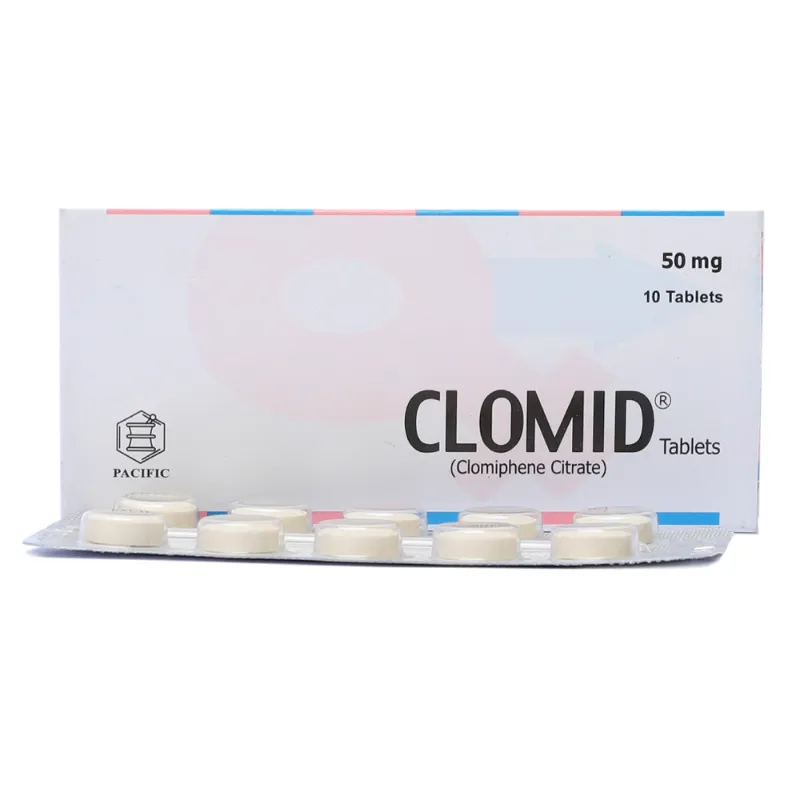Overview of Clomid
1. General Introduction
Clomid (clomiphene citrate) is a medication used primarily to treat infertility in women. It belongs to a class of drugs known as selective estrogen receptor modulators (SERMs). Clomid works by stimulating ovulation, making it easier for women to conceive. It is commonly prescribed for women with ovulatory dysfunction, including polycystic ovary syndrome (PCOS).
2. Primary Purpose
The primary purpose of Clomid is to induce ovulation in women who have difficulty ovulating naturally. By stimulating the release of hormones necessary for ovulation, Clomid helps improve the chances of pregnancy.
3. Key Benefits and Properties
Clomid offers several key benefits and properties that make it an effective treatment option for infertility:
- Ovulation Induction: Stimulates the release of hormones needed to induce ovulation.
- Non-Invasive: Oral medication, providing a less invasive alternative to injectable fertility treatments.
- Well-Tolerated: Generally well-tolerated with a favorable safety profile.
- High Success Rate: High rates of ovulation induction, making it a first-line treatment for many women with infertility issues.
4. Efficacy
Clinical studies have demonstrated the efficacy of Clomid in inducing ovulation and increasing pregnancy rates in women with ovulatory dysfunction. Many women experience successful ovulation and an increased chance of conception with Clomid treatment.
5. Safety and Tolerability
Clomid is generally well-tolerated by most patients, but it can cause side effects. Common side effects include hot flashes, bloating, breast tenderness, and mood swings. These side effects are usually mild and temporary. Serious side effects are rare but can include ovarian hyperstimulation syndrome (OHSS) and multiple pregnancies (twins or more). Regular monitoring by a healthcare provider is recommended to ensure safety during treatment.
6. Convenience of Dosing
Clomid offers convenient dosing, typically administered as a 50 mg tablet taken once daily for five days during the early part of the menstrual cycle. This simple dosing regimen helps improve adherence and ensures consistent therapeutic effects.
Indications for Use of Clomid
1. Conditions Treated by Clomid
Clomid (clomiphene citrate) is primarily indicated for the treatment of infertility in women with ovulatory dysfunction, including:
- Polycystic ovary syndrome (PCOS)
- Anovulation (absence of ovulation)
- Irregular menstrual cycles
- Unexplained infertility
2. Symptoms and Indications
- Ovulatory Dysfunction: Helps women who have irregular or absent ovulation to achieve regular ovulation, increasing the chances of pregnancy.
Dosage and Administration of Clomid
1. Dosage and Intake
- Recommended Dosage: The typical starting dose of Clomid is 50 mg, taken orally once daily for five days. The treatment usually starts on the fifth day of the menstrual cycle.
- Maintenance Dosage: If ovulation does not occur, the dose may be increased to 100 mg daily in subsequent cycles, up to a maximum of 150 mg per day.
2. Timing of Administration
- Regular Doses: Clomid should be taken once daily for five consecutive days, starting on the fifth day of the menstrual cycle.
- Missed Dose: If a dose is missed, it should be taken as soon as remembered. If it is close to the time for the next dose, skip the missed dose and resume the regular dosing schedule.
3. Additional Recommendations
- With or Without Food: Clomid can be taken with or without food, providing flexibility in administration.
- Follow Prescription Guidelines: Adhere to the prescribed dosing schedule and consult a healthcare provider before making any changes to the dosage.
Mechanism of Action of Clomid
1. Description of Mechanism
Clomid works by blocking estrogen receptors in the hypothalamus, a part of the brain that regulates hormone production. This blockage leads to an increase in the release of gonadotropin-releasing hormone (GnRH), which stimulates the pituitary gland to produce more follicle-stimulating hormone (FSH) and luteinizing hormone (LH). These hormones are essential for the growth and release of mature eggs from the ovaries.
2. Biochemical Processes
- Estrogen Receptor Modulation: Clomid binds to estrogen receptors in the hypothalamus, preventing estrogen from binding and signaling.
- Hormonal Stimulation: Increased GnRH release stimulates the pituitary gland to produce more FSH and LH, leading to ovulation.
3. Physiological Effects
- Induced Ovulation: The increase in FSH and LH levels stimulates the growth and release of a mature egg from the ovary.
- Improved Fertility: Regular ovulation increases the chances of conception in women with ovulatory dysfunction.
Composition of Clomid
1. General Introduction
Clomid is composed of both active and inactive ingredients that work together to provide its therapeutic effects.
2. Active Ingredients
- Clomiphene Citrate: The active component in Clomid, clomiphene citrate, is responsible for its ovulation-inducing effects.
3. Inactive Ingredients
- Excipients: These may include substances such as lactose, magnesium stearate, microcrystalline cellulose, and other agents that help form the tablet and ensure its stability and efficacy.
Side Effects of Clomid
1. General Introduction
While Clomid is generally well-tolerated, it can cause side effects in some patients. Awareness of these potential side effects helps in managing them effectively.
2. Possible Side Effects
- Common Side Effects: Hot flashes, bloating, breast tenderness, mood swings, nausea, and headache. These effects are usually mild and temporary.
- Less Common Side Effects: Some patients may experience blurred vision, dizziness, and abdominal pain.
3. Frequency and Severity
- Mild to Moderate: Most side effects are mild to moderate in severity and tend to diminish as the body adjusts to the medication.
- Severe: Rarely, severe side effects such as ovarian hyperstimulation syndrome (OHSS) and multiple pregnancies may occur. Immediate medical attention is required in such cases.
Prevention of Side Effects
1. General Introduction
Preventing side effects involves following the prescribed dosage and usage guidelines carefully.
2. Tips to Prevent Side Effects
- Follow Dosage Instructions: Adhering to the prescribed dosage reduces the risk of side effects.
- Monitor Symptoms: Regular monitoring of symptoms and side effects by a healthcare provider can help detect and manage issues early.
3. Recommendations for Improving Tolerance
- Gradual Adjustment: If side effects are bothersome, consult a healthcare provider for potential dose adjustment.
- Report Adverse Effects: Reporting any adverse effects to a healthcare provider ensures timely management and adjustment of the treatment plan.
Contraindications for Clomid
1. General Introduction
Certain conditions and factors may contraindicate the use of Clomid.
2. Conditions and Diseases
- Pregnancy: Clomid should not be used during pregnancy.
- Liver Disease: Clomid is contraindicated in patients with liver disease or a history of liver dysfunction.
- Uncontrolled Thyroid or Adrenal Disorders: These conditions should be managed before starting Clomid treatment.
- Ovarian Cysts: Clomid should not be used in patients with ovarian cysts that are not related to polycystic ovary syndrome (PCOS).
3. Warnings for Different Patient Groups
- Women with Hormonal Imbalances: Patients with underlying hormonal imbalances should be evaluated and treated appropriately before starting Clomid.
- Patients with Visual Disturbances: Clomid may cause visual disturbances, which should be monitored closely.
Warnings and Precautions
1. General Introduction
Taking certain precautions can minimize risks associated with Clomid use.
2. Important Warnings
- Monitor for OHSS: Patients should be aware of the signs of ovarian hyperstimulation syndrome (OHSS) and seek immediate medical attention if they occur.
- Avoid Use in Pregnancy: Clomid should not be used once pregnancy is confirmed.
3. Measures for Minimizing Risks
- Regular Monitoring: Regular follow-up visits with a healthcare provider to monitor progress and side effects.
- Communicate Concerns: Patients and caregivers should communicate any concerns or adverse effects to their healthcare provider promptly.
Missed Dose
1. What to Do if a Dose is Missed
If a dose of Clomid is missed, it should be taken as soon as remembered. If it is close to the time for the next dose, skip the missed dose and resume the regular dosing schedule.
2. Tips for Adhering to Dosing Schedule
- Set Reminders: Use alarms or reminders to remember to take the medication.
- Keep a Log: Maintain a log or chart to track dosing times.
Drug Interactions
1. Introduction
Clomid can interact with other medications, affecting its efficacy and safety.
2. Examples of Interactions
- Hormonal Medications: Concurrent use with other hormonal treatments can affect the efficacy of Clomid.
- Anticoagulants: Clomid may interact with blood thinners, increasing the risk of bleeding.
3. How to Avoid Negative Interactions
- Inform Healthcare Providers: Always inform healthcare providers about all medications being taken.
- Follow Guidelines: Adhere to medical guidelines and avoid unapproved combinations of medications.
Overdose
1. Symptoms of Overdose
Symptoms of a Clomid overdose can include nausea, vomiting, visual disturbances, and ovarian hyperstimulation.
2. Actions to Take in Case of Overdose
- Seek Immediate Medical Attention: Contact emergency services or go to the nearest emergency room.
- Do Not Induce Vomiting: Unless instructed by a healthcare provider, do not attempt to induce vomiting.
Pharmacokinetics of Clomid
1. Absorption
Clomid is well-absorbed from the gastrointestinal tract, with peak plasma concentrations occurring within 5 to 7 hours after oral administration.
2. Distribution
Clomid is widely distributed throughout the body and has a high affinity for binding to tissues, including the ovaries and the liver.
3. Metabolism
Clomid is metabolized in the liver to its active and inactive metabolites, which are then excreted in the bile and urine.
4. Elimination
The drug and its metabolites are excreted mainly in the feces and urine. The elimination half-life of Clomid ranges from 5 to 7 days.
Dosage Forms
1. Available Forms and Dosages
Clomid is available in tablet form, typically in a dosage of 50 mg. These dosage forms provide convenience and accuracy in administration.
2. Advantages of Dosage Forms
- Tablets: Convenient for routine use and easy to dose accurately.
Pregnancy and Breastfeeding
1. Safety of Use
The safety of Clomid during pregnancy and breastfeeding has specific considerations:
- Pregnancy: Clomid should not be used during pregnancy. If pregnancy is confirmed during treatment, Clomid should be discontinued.
- Breastfeeding: The safety of Clomid during breastfeeding has not been established, and it is not recommended for use in nursing mothers.
2. Recommendations for Pregnant and Nursing Mothers
- Not Recommended: Clomid should not be used by pregnant or breastfeeding women.
Storage Conditions
1. Storage Recommendations
Clomid should be stored at room temperature, away from light and moisture. Keep it out of reach of children and pets.
2. Temperature and Other Conditions
- Optimal Temperature: Store Clomid at a temperature between 20°C to 25°C (68°F to 77°F).
- Avoid Humidity: Keep the medication in a dry place to maintain its efficacy.
Clinical Trials and Efficacy
1. Overview of Clinical Studies
Clinical trials have demonstrated the efficacy of Clomid in inducing ovulation and increasing pregnancy rates in women with ovulatory dysfunction. These studies confirm its effectiveness in improving fertility outcomes.
2. Main Results and Findings
- Ovulation Induction: High rates of successful ovulation induction.
- Pregnancy Rates: Increased chances of conception and pregnancy reported by users.
Conclusion
1. Summary of Clomid
Clomid is an effective medication for managing infertility in women with ovulatory dysfunction. Its benefits include inducing ovulation, improving fertility outcomes, and convenient dosing options. Clomid offers a valuable treatment option for women seeking to improve their chances of conception.
2. Main Benefits and General Recommendations
- Benefits: Effective in treating infertility, well-tolerated, convenient dosing options.
- Recommendations: Follow prescribed dosages, monitor for side effects, and consult healthcare providers regularly for optimal management of infertility.


